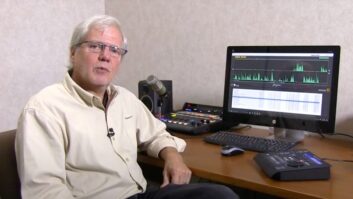EAS equipment manufacturer Digital Alert Systems examined audio captures of last week’s EAS test and said its information points to an equipment failure in a connection between the FEMA Operations Center and PEP radio station WCCO in Minneapolis as the cause of one of the problems that broadcasters reported. Neither CBS nor FEMA has confirmed this detail, however.
Edward Czarnecki, senior director of strategy, development & regulatory affairs for Monroe Electronics Inc. and Digital Alert Systems, pointed to that link in a Q&A with Radio World in which he also discussed his perspectives on the test five days later.
What did the industry learn from the national EAS test?
There are a variety of lessons that can be taken away by government, broadcasters and EAS equipment manufacturers. We found out some good news in areas where the EAS relay worked, delivering the EAN test message as anticipated. Similarly, we found out some areas were the EAS relay needs some attention. Finding out that kind of information is also a good result from this test.
Aside from the relay, there were problems with the EAN message itself that need to be addressed. There were apparently several technical and operational issues at FEMA and some of the PEPs that warrant attention.
Still, it deserves to be noted that the FCC and FEMA took a considerable risk by conducting such a high-profile nationwide-test. The reward should eventually be a much improved public warning capability in this country. Inevitably, there has been much criticism in both the mainstream press and within industry. However, these agencies should at least be credited for finally taking the leap to conduct this long-needed test of the national EAS, not something many agencies would dare to do in today’s political climate.
What’s your understanding of why the test did not go off smoothly and did not reach all areas of the country?
There were a range of monitoring and configuration issues at individual broadcast and cable sites and at various EAS relay points. However the largest and most fundamental issues arose at the origination of the message, which had a cascading effect across the nation. The most common problems witnessed nationwide were severe audio issues, either echoed secondary EAS tones within the audio portion of the message, or tones without any audio. These echoing EAS header and EOM echoes originated from within the PEP system, an internal feedback loop from one of the PEPs back into the FEMA bridge and out again. These additional EAS tones seem to have posed several challenges in the airing of the alert, such as prematurely terminating the audio. …
We examined audio captures of the EAN test from sites across the country, both DASDEC users and users of other equipment, and were able to fully decode one of the feedback headers that erroneously appeared in the audio. Decoded, the second “mystery header” appeared as follows: ZCZC-PEP-EAN-011001+0015-3131903-WCCO. This string identifies the PEP station that was the source of the audio. Evidently, there was an equipment failure in the connection between the FEMA Operations Center and that PEP radio station.
Parenthetically, note that if you listen carefully to the audio portion of the message, you’ll notice a continued feedback loop. So there was not just one set of EAS tones, but several, each increasingly less audible — a fading echo.
A successful outcome from this national test will be the identification of what caused that audio feedback, and implementation of safeguards so it doesn’t occur again.
Another problem in at least one region was caused by a possible malfunction in the EAS equipment at another PEP, which resulted in no transmission of the EAN from the PEP in that area. That, of course, posed a challenge in relaying the EAN to at least one region.
Yet another issue was found in the timing of the EAN message originated by FEMA. The effective time of the message as found out to be three minutes after it was sent out by FEMA. It also appears the EAS encoder used by FEMA has a clock that was not properly set, and was fast by some three minutes. That effective time appeared of course in both the intended EAN header, as well as the” echo headers” within the audio.
Was the national test a success, failure or somewhere in between?
I would simply observe that this test was intended to a system-wide diagnostic. As a result, all parties – government, broadcasters, and equipment manufacturers – finally have an opportunity to objectively examine a range of issues, and systematically address them. Calling this a “test” was unfortunate, in that the word implies a pass or fail. I don’t think was not intended to be the case, though of course any nationwide exercise like this is going to come with some fairly high stakes. If we all come away with a better understanding of the process and of areas to improve, then the test could be considered a success.
However, I think we need to separate the process from the results … isolate the methodology from the outcome. Whatever the outcome of the test, we now have some information from which to learn and improve. At the same time, the methodology of this national test deserves examination, and this may also be an area where future tests can do better. A number of commentators have observed that the test may have been contaminated in various ways, importantly where EAS participants monitored sources other than those they would usually monitor. By doing this, a random variable was allowed to be introduced into one of the key points of the test – to determine if the national EAS relay works.
For the EAS system overall, there are a large number of potential lessons emerging from the national test. More will likely emerge as a result of the FCC’s survey of all EAS participants. Parts of the national EAS relay continue to need to be addressed – there are still relay gaps that may need to be filled in either by adding additional Primary Entry Points, or by adjusting monitoring assignments. There were issues in the origination of the EAS message and communications systems between FEMA and the PEP stations – and this is certainly something that FEMA is already looking into.
What technical issues were reported by users of your equipment, if any?
We’ve received a good amount of feedback from our customers who are using the Digital Alert Systems DASDEC II CAP/IPAWS compliant EAS encoder/decoder (broadcast radio and television) and the OneNet (cable TV and IPTV). Customers have observed how the DASDEC II’s were really put to the test today by some truly challenging input from the PEP system — multiple EAS tones, poor audio, etc. By far, our customers have been pleased with how the DASDEC performed. Potential improvements we learned from this EAN test could easily be provided to our customers via a quick software update.
Several of our customers have noted that a big asset of having a DASDEC or One-Net is the amount of information we can store in the log. Customers have contacted us to help them read the logs to look deeper into the issue areas encountered by EAS participants across the country. Why was the audio so bad? Why could some not decode an alert (because they received only two headers and they didn’t match)? What in some cases caused the audio to end abruptly (the background EOM tones running in the audio)? As these folks look to fill out the FCC Form 2 and 3, this will be their best tool to understand what worked and what didn’t.
What should broadcasters be thinking or doing now that this test is past?
Overall, the broadcast community did what it should, and then some. Credit should go to the many engineers across the nation who invested significant amounts of time and effort to supporting this national test. This needs to be acknowledged.
I think one thing we all can do is to step back and take a breath. We need to think carefully about what happened. Stay calm. Don’t panic. File your Forms 2 and 3. And let’s see what the findings are from the FCC. Let’s all pull ourselves together and work as a team to identify and fix the issues.
Any other key points?
I think that another national EAS test should be run in the relatively near future, perhaps sometime after the FCC publishes its revised Part 11 EAS rules. This test needs a re-do for a variety of reasons. so we can better examine additional issues in the EAS national relay. The FEMA alert product was fatally flawed from the outset, so that in and of itself should require another go.
However, I would suggest segmenting the test into several elements. Perhaps a next try in several months with a nationwide Required Monthly Test (RMT) instead of an EAN. That would avoid the need to ramp up with so much public outreach, but still allow FEMA and FCC to test the EAS relay across the nation. I think the relay itself deserves a re-test since, in some areas, folks were improvising and trying to find ways to “fix” the EAS relay even before the test, and in a few other areas the PEP could not transmit the alert. I would suggest that it would be more appropriate to test the entire system “as-is”, rather than let the diagnosis be contaminated.
After a national RMT, then try the EAN test code again in a year or so. Learning from this national test will hopefully in incorporated into the revised FCC Part 11 EAS rules that are anticipated to be released somewhere around the end of the year. And after that, perhaps a national RMT based on the new CAP capability.







